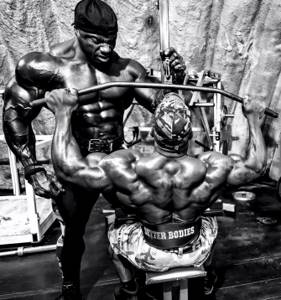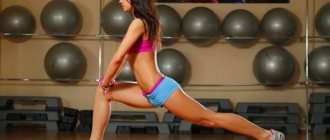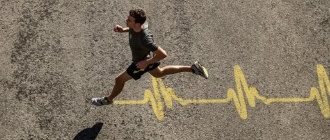What happens to the body
When exercising for strength, the body's adaptation results in an increase in muscle volume. To obtain maximum results, the correct rest interval between sets and between strength training sessions must be observed. This allows the muscles and the body as a whole to recover from the impact, which makes the next session more effective.
Scientific research on strength training is available here.
But when performing an endurance program, the body’s adaptation will occur in a completely different way. The main goal is to increase the aerobic capacity of the muscles. That is, increase the time at which the muscle will perform work of a given intensity. Such training does not increase muscle strength, but has a good effect on the performance of the cardiovascular system.
Advice for beginners: you should know that working on endurance affects not only the development of this quality in the muscles. Much more important is the development of cardiac endurance. Cyclic exercises performed with sufficient oxygen supply to the body increase the payload on the heart, slightly increasing its size. As a result, the heart requires fewer contractions because the internal volume has increased, which means your internal pump will work longer and more efficiently.
Why do you need endurance anyway?
It is an undeniable fact that being physically fit is very good for your health. Let's figure out why.
Firstly, under increased stress, the human body begins to work differently. Oxygen enters the blood better, carbohydrates are converted into energy, and excess fats are eliminated. This means that the body receives more useful and nutritious substances.
Secondly, heart function noticeably improves. In addition, the lungs work better.
This is why developing strength endurance is a very important task for any athlete, whether professional or amateur. Of course, with experience in training everything will come on its own, but this takes time. If you want to develop endurance faster, there are a number of special exercises. Most often they are used by those who find themselves in kettlebell lifting or Russian bench press.
Impact of simultaneous operation
Theoretical studies of some scientists show that it is very difficult to combine the development of these two parameters simultaneously. They say that strength work does not increase the aerobic capacity of muscles. And endurance work often reduces the effect of strength training. And quite popular circuit training programs negatively affect the development of both of these qualities.
Researchers recommend not trying to combine these two types of exercise, but dividing the programs on different days. That is, conduct 2-3 days a week of strength training and 2-3 days of time for endurance exercises. And at the same time, circular programs should be abandoned.
The Best Strength and Endurance Exercise You Can Do at Home
One of the ways to develop endurance is also considered to be cycling for a long time to improve the endurance and strength of the leg muscles! The difference between group classes and cycling is that when you run or ride a bike, you mainly train your legs, but in group classes the trainer builds the entire load evenly on all muscle groups so that all muscles receive the load evenly!
There are other methods of developing endurance, which we will write about soon, and the methods we wrote about above are considered the best and most effective among girls and women, men who have lost weight in exactly these ways and improved their body and figure, as well as and lost extra pounds of fat.
Endurance in a person develops when the body is in a state in a certain pulse zone and at the same time performs a prolonged load on the muscles in a certain time interval.
What can such activities lead to?
A strength and endurance training program, according to some scientists, can lead to the following consequences.
- Extreme fatigue. Most often it happens when an athlete tries to combine work on both qualities in one cycle. Already the first part of the approaches leads to severe fatigue, so the second part of the approaches is ineffective.
- Overtraining. Appears when there is insufficient rest between workouts. If an athlete does not alternate types of programs, but performs a circuit program at each lesson, then overtraining occurs faster.
- Neuromuscular adaptations. They appear in the muscles that do the main work, thereby reducing the effectiveness of strength exercises.
- Low adaptation to two types of work. With a circuit program, the athlete’s body will try to adapt to two types of work at once. But more often than not, such adaptation is very difficult for the body and does not give the desired effect (expert’s note: a study was conducted in 1999, on the basis of which such conclusions were made).
- Violation of the anabolic-catabolic balance. A predominance of catabolic processes appears, which negatively affects the effect.
Iron Health

Planning a traditional unidirectional workout (for example, strength) is not difficult. When training for strength, you need to work with weights, performing exercises in the most intense manner possible (heavy working weight, low number of repetitions). To train endurance, you need low-intensity exercises performed for a long time - this can be training in the gym with light weights and a large number of approaches and repetitions, or any other endurance exercises (running, swimming, cycling). There are no problems in building one or another training scheme, but what if you need to increase both strength and endurance within the same program or period of time?
Peculiarities of body adaptation during strength loads and endurance training
The main means of adaptation of the body to power loads is muscle hypertrophy and the associated increase in strength. At the same time, one of the main factors of strength training is long periods of rest - both between sets of exercises and between individual strength training sessions. An optimal rest regime will allow you to maintain your training at the required level of intensity, which will be the basis for its effectiveness.
See article - Strength Development: Mechanism of Action.
If we talk about adaptation to endurance training , then the situation is completely different. The main parameter here is an increase in the aerobic capacity of the muscle - that is, an increase in the time during which it can perform exercises of a given intensity and at a higher aerobic capacity than it was in the previous workout. This type of training increases cardiovascular strength, but does not affect either strength or muscle size (NSCA study, 2000).
See article - Developing endurance: mechanism of action.
Is it possible to improve strength and endurance parameters at the same time?
Many scientists do not share the position of some athletes that it is possible to increase muscle strength and endurance at the same time. And there are a number of reasons for this. First, strength training does not improve the body's aerobic capacity. Second, endurance training can dilute the effectiveness of pure strength training.
NSCA research has shown that simultaneous improvements in an athlete's strength and endurance are unlikely to be possible, since such training negatively affects the body's adaptation to both strength and endurance training. In particular, endurance athletes experienced little or no improvement in performance when using concurrent training. For strength-oriented athletes, simultaneous training generally had a negative impact and was marked by a decrease in intensity in the main strength exercises. Thus, training both physical parameters at the same time most often reduced the athlete’s main parameter (be it strength or endurance). Why might concurrent training reduce strength/endurance development?
- Acute fatigue . May occur when strength and endurance training are performed on the same day. The first period of training will lead to exhaustion, which will minimize the effectiveness of the second period.
- Neuromuscular adaptations - occur in fast and slow twitch motor groups and reduce the effectiveness of strength training, preventing the development of strength.
- Overtraining – systematic simultaneous training with insufficient recovery period will lead to stagnation. Athletes who practice simultaneous training are more likely than others to experience overtraining.
- Inability to adapt to two types of training at once . Of course, the body will try to adapt to the extremes of the two types of training, but such a regime will be difficult, if not impossible (Leveritt et al. 1999).
- Negative anabolic-catabolic balance . Simultaneous strength and endurance training can lead to a negative balance between anabolic and catabolic processes. At the same time, the predominance of catabolic processes will negatively affect the growth of muscle mass and strength, and will also create additional conditions for the onset of overtraining.
Correct conclusions
And although many studies have shown the negative effects of simultaneous strength and endurance training, there are still positive aspects. For example, incorporating some strength training into an endurance program has been shown to improve heart, lung, and circulatory health (2000 NSCA study). In addition, it has been proven that the inclusion of strength training in the endurance complexes of athletes involved in high-intensity running (short sprints) and cycling significantly delayed the onset of fatigue and made the “finishing spurt” more powerful.
Simultaneous training in practice
And although scientific research says that joint programs will not bring any benefit, in practice everything turns out somewhat differently. Strength and endurance training can help athletes improve their performance in some cases. This happens best if you add several strength approaches to your endurance program. Classic examples are sports such as sprinting, cycling and the like, where a final push is required at a certain point. Working on strength in this case will not add volume to the muscles, but will improve the athlete’s strength performance. It is only important to maintain a balance between approaches and understand which of the developed qualities is the main one.
For example, there is a course work: Development of strength and endurance in skiers aged 14–15 years using the method of circuit training
Or Methodology for developing strength and endurance in workout classes
We offer readers an approximate training program designed for strength and endurance. You should not blindly perform all the suggested exercises, since everyone’s body is different. Therefore, before classes, with the help of an experienced trainer, adapt the program to your capabilities. Keep in mind that the calculation is made for a weekly cycle, and it is advisable to perform the entire volume of exercises in order to achieve maximum results.
Exercises at home for strength and endurance for girls
Knowing the basics of exercises with your own weight on the abs, legs, back, arms, chest, you can easily create a set of exercises for all muscle groups at home and train without dumbbells at home, following all the rules of how to properly train at home! Over time, you will see the results of such training.
Abdominal exercises that improve strength and endurance
- Torso bending while lying on your back
- Plank
- T bar
- Bike
- Scissors
- Single leg plank
- Pulling your legs to your chest
- Riveting
- Harmonic
- Reverse crunches
- Swing your legs up and down
- Running in place
- Oblique crunches
Exercises for the legs and buttocks that affect strength and endurance in girls and men
- Pulling the leg back onto the buttock
- Classic squats
- Lunges in place
- Abduction of a straight leg diagonally to the buttock
- Lifting the pelvis while lying up on one leg
- Lifting the pelvis while lying up on two legs
- Jump Squats
- Sumo squats
- Cross to cross lunges
Exercises for the chest and arms that affect strength and endurance in girls and men
- Classic push-ups
- Knee push-ups
- Push-ups with cotton
- One-arm push-ups
Back exercises that affect strength and endurance in girls and men
- boat
Day 1
The complex is performed in the hall. To work with barbells and dumbbells, take the weight that you are usually used to working with. Next, circuit training is performed, each exercise is done 10 times in 3 approaches. The intensity and frequency should directly depend on your physical fitness. For beginners, it is recommended to start with a weight of 5 kg, and then gradually increase this weight.
- Squat with a barbell.
- One of the basic calf exercises.
- A couple of different complexes for the biceps brachii muscle.
- Hyperextension.
- Ellipse for 20 minutes.
Basic training program

As noted, strength endurance has nothing to do with strength training. In the second case, the main goal of the athlete is to develop muscle strength, pump them up, and give them the desired shape.
A beginner will not be able to develop such a training program on his own. This should be done by the trainer, taking into account all the characteristics of the human body. In general, any program is based on the fact that the athlete lifts the maximum possible weight for himself, taking long breaks between approaches. Such classes are held several times a week and usually consist of three approaches to each exercise. Basic exercises are squats, bench press, pull-ups, exercises with dumbbells, exercises with a barbell.
Day 3
It is advisable to perform jumping exercises indoors, and running exercises outdoors.
- Jumping rope lying on the floor, sideways. When jumping, you should try to bring your legs as close to your buttocks as possible. Jumps are performed for 30 seconds, and 3 approaches are done.
- Jump up in the starting position with your feet shoulder-width apart. During the jump, you should try to raise your legs bent at the knees in front of you. Perform in the same time as the first jumps.
- Running in place at a gallop. When running, you need to use your arms as intensely as possible in time with your legs. The run lasts 1 minute, you need to do 10 such approaches.
- Starting position – sumo stance. In this starting position, without straightening, you need to walk to the sides. The back should be as straight as possible. You need to move for 1 minute, and there should be 5 such approaches.
- Maintaining balance using the Swallow exercise. Performs for 30 seconds, you need to do 5 approaches.
- Running to higher ground. The number of repetitions varies depending on the height of the hill. It is necessary to make from 5 to 10 such ascents. You should run up at maximum speed, and go down at a slow pace.
Push-ups and exercises on the horizontal bar
It is important to do push-ups correctly. You can get ahead of everyone in quantity, but there will be no point, because quality is more important. Make sure you breathe correctly: when you go up, exhale, when you go down, inhale. The back is always straight. The number of approaches must be gradually increased from one to five.
As for the horizontal bar, in this case four approaches are optimal. They involve as many pull-ups as you can do. The body is straight, legs are extended. As we rise, we inhale.











